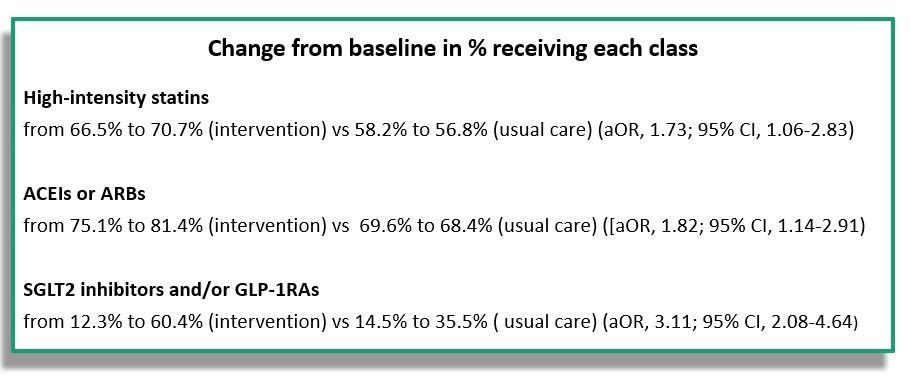Likelihood of Optimal GDMT for Patients with T2D, ASCVD Increased with Multifaceted Clinic Intervention
A coordinated multifaceted intervention focused on collaborative care and reducing barriers to optimal pharmacotherapy increased the likelihood by 4-fold that patients with type 2 diabetes (T2D) and atherosclerotic cardiovascular disease (ASCVD) would be prescribed 3 classes of guideline-directed medical therapies (GDMT) when compared to usual care.
According to study findings, an absolute increase of 23.4% in prescriptions for all 3 recommended categories (ie, high-intensity statins, ACE inhibitors or ARBs, and sodium-glucose cotransporter 2 [SGLT2] inhibitors and/or glucagon-like peptide 1 receptor agonists [GLP-1RAs]) in the intervention vs the usual care group was “more than twice the improvement the trial was designed to detect,” according to study authors.
The research findings were presented at the American College of Cardiology’s (ACC) 2023 Annual Scientific Session Together with the World Congress of Cardiology and published simultaneously online March 6 in JAMA.
“As important as it is to develop new therapies, it is at least as important, if not more important, to focus on actually getting those therapies to the patients who need them,” said lead investigator Neha J. Pagidipati, MD, MPH, associate professor of medicine in cardiology at Duke University School of Medicine and Duke Clinical Research Institute, in an ACC press statement. He adds that the study findings are very promising, “especially in comparison with the staggering underuse of these therapies in routine clinical practice.”
The study findings are very promising, “especially in comparison with the staggering underuse of these therapies in routine clinical practice.”
Pagidipati and colleagues hypothesized that a multifaceted intervention that included assessment, education, and feedback would lead to an increase in prescribing for the 3 classes of GDMT. They tested the hypothesis in COORDINATE (Coordinating Cardiology Clinics Randomized Trial of Interventions to Improve Outcomes)-Diabetes, a cluster randomized clinical trial conducted at 43 US cardiology clinics with participants recruited from July 2019 to May 2022 and follow-up continuing through December 2022.
Investigators randomized the clinics to the intervention or usual care. The study intervention comprised 6 components on which clinic personnel were trained by a group of 3 study clinicians (the trial trio)—a cardiologist, endocrinologist, and implementation specialist:
- A clinic-specific analysis of the barriers to evidence-based care
- Development of local interdisciplinary care pathways to address barriers.
- Coordination of care between clinicians (cardiologists, endocrinologists, primary care clinicians)
- Clinician education with a focus on current clinical guidelines, evidence for use of the 3 drug classes, and implementation of treatment in clinical care.
- Audit and feedback of quality metrics on treatment at home clinic as well as at other intervention clinics.
- Participant educational materials on GDMT and rationale for treatment
Clinics in the usual care group were provided with current clinical practice guidelines from the American College of Cardiology/American Heart Association and the American Diabetes Association on the management of type 2 diabetes and atherosclerotic cardiovascular disease.
Pagidipati et al defined the trial’s primary outcome as the proportion of participants prescribed all 3 groups of recommended therapies at 6-12 months after enrollment. For secondary outcomes, the team identified changes in ASCVD risk factors and a composite outcome of all-cause death or hospitalization for myocardial infarction, stroke, decompensated heart failure, or urgent revascularization. Of note, the trial was not powered to show these differences.
A total of 1049 participants with T2D and ASCVD comprised the final cohort. Among them, 459 were recruited from 20 intervention clinics and 590 were recruited from 23 usual care clinics. Median age of participants was 70 years and 32.3% were women; 16.5% were Black, and 8.6% were Hispanic.
FINDINGS
At the last follow-up visit (12 months for 97.3% of participants), investigators reported, those receiving care at intervention-guided clinics were 4 times more likely to be prescribed medications in all 3 medication groups vs those at clinics providing usual care (37.9% vs 14.5%; adjusted odds ratio [aOR], 4.38 [95% CI, 2.49-7.71]; P <.001). When investigators analyzed participant use by individual drug class, intervention clinic patients also were more likely to be prescribed medication in each of the 3 therapy classes (see below).

An analysis of the proposed secondary outcomes revealed no changes in ASCVD risk factors between the intervention and usual care groups. The composite secondary outcome was observed in 5% of those in the intervention group and 6.8% of those in the usual care group (adjusted hazard ratio [aHR], 0.79 [95% CI, 0.46-1.33]).
The authors write that their findings suggest while clinician behavior “has historically proven difficult to change, an intervention with multiple synergistic components can have an effect on clinician prescribing patterns for evidence-based therapies.”
Multidisciplinary care to optimize outcomes for high-risk patients like those in the study is critical given the burden and toll of T2D and ASCVD, said coauthor Christopher Granger, MD, professor of medicine in the Division of Cardiology at Duke University, in a statement from Eli Lilly.
He adds, “We have shown, with the highest level of evidence through randomization, that patients will get better care when they are treated by a dedicated team of doctors and specialists, with assessment of barriers, tools to address barriers, care pathways and feedback, with education of both providers and patients.”
The study was co-funded by Eli Lilly and Company and Boehringer Ingelheim
Reference: Pagidipati NJ, Nelson AJ, Kaltenbach LA, et al. Coordinated care to optimize cardiovascular preventive therapies in type 2 diabetes: a randomized clinical trial. JAMA. Published online March 6, 2023. doi:10.1001/jama.2023.285